An Analysis of Unsustainable Tourism Development in Developing Nations
VerifiedAdded on 2021/06/14
|10
|2248
|71
Report
AI Summary
This report delves into the critical issue of unsustainable tourism development, particularly focusing on its impact on developing countries. It begins by establishing the importance of the tourism industry, highlighting its economic contributions and rapid growth globally, especially in regions like Asia-Pacific and Africa. The report then defines sustainable tourism, emphasizing its role in balancing industry growth with social, environmental, and economic considerations. It contrasts this with unsustainable practices prevalent in many developing nations. The core of the report analyzes the challenges that hinder sustainable tourism, including a lack of incentives, inadequate knowledge within the industry, low market demand for sustainable options, and weak regulatory frameworks. The report underscores the urgent need for sustainable practices to mitigate the negative impacts of tourism and protect both the environment and the economic well-being of these countries. It concludes by reiterating the necessity of addressing these issues to ensure the long-term viability and sustainability of the tourism industry.
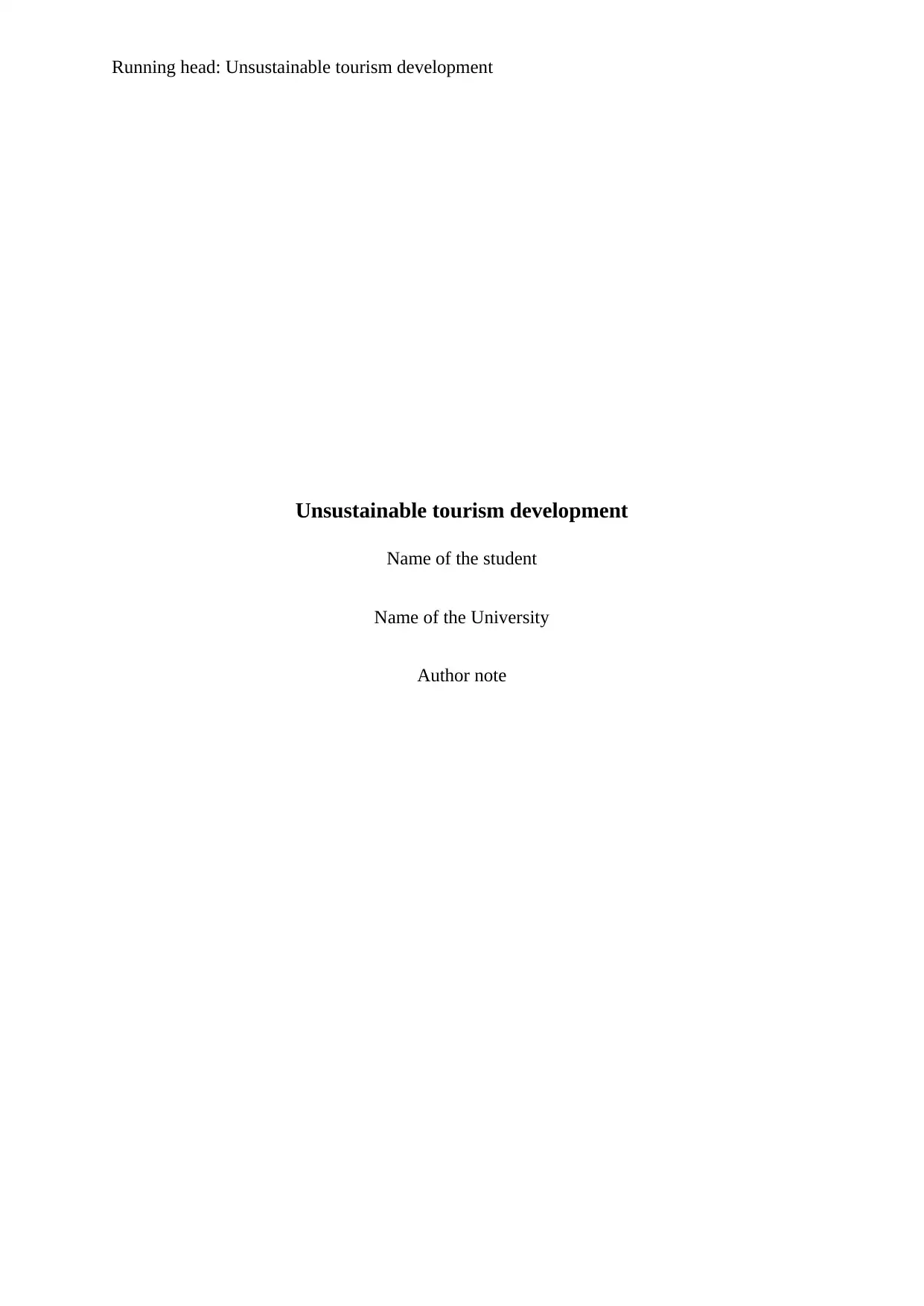
Running head: Unsustainable tourism development
Unsustainable tourism development
Name of the student
Name of the University
Author note
Unsustainable tourism development
Name of the student
Name of the University
Author note
Paraphrase This Document
Need a fresh take? Get an instant paraphrase of this document with our AI Paraphraser

Running head: Unsustainable tourism development
Executive summary
The study intends to discuss the unsustainable development of the tourism industry in the
developing countries. The tourism development in the developing countries is largely
unsustainable for not having proper amenities. Therefore the report focuses on the topic as it
need immediate attention in order to protect the environment even though the tourism
industry is growing all over the world in a rapid pace. In order to discuss the un-sustainability
of tourism industry, the report discusses the sustainable tourism development at first in the
context of developing countries and in the later part the discussion, highlights how the
tourism industry is unstable in the developing countries by elaborating the challenges and
issues.
Executive summary
The study intends to discuss the unsustainable development of the tourism industry in the
developing countries. The tourism development in the developing countries is largely
unsustainable for not having proper amenities. Therefore the report focuses on the topic as it
need immediate attention in order to protect the environment even though the tourism
industry is growing all over the world in a rapid pace. In order to discuss the un-sustainability
of tourism industry, the report discusses the sustainable tourism development at first in the
context of developing countries and in the later part the discussion, highlights how the
tourism industry is unstable in the developing countries by elaborating the challenges and
issues.
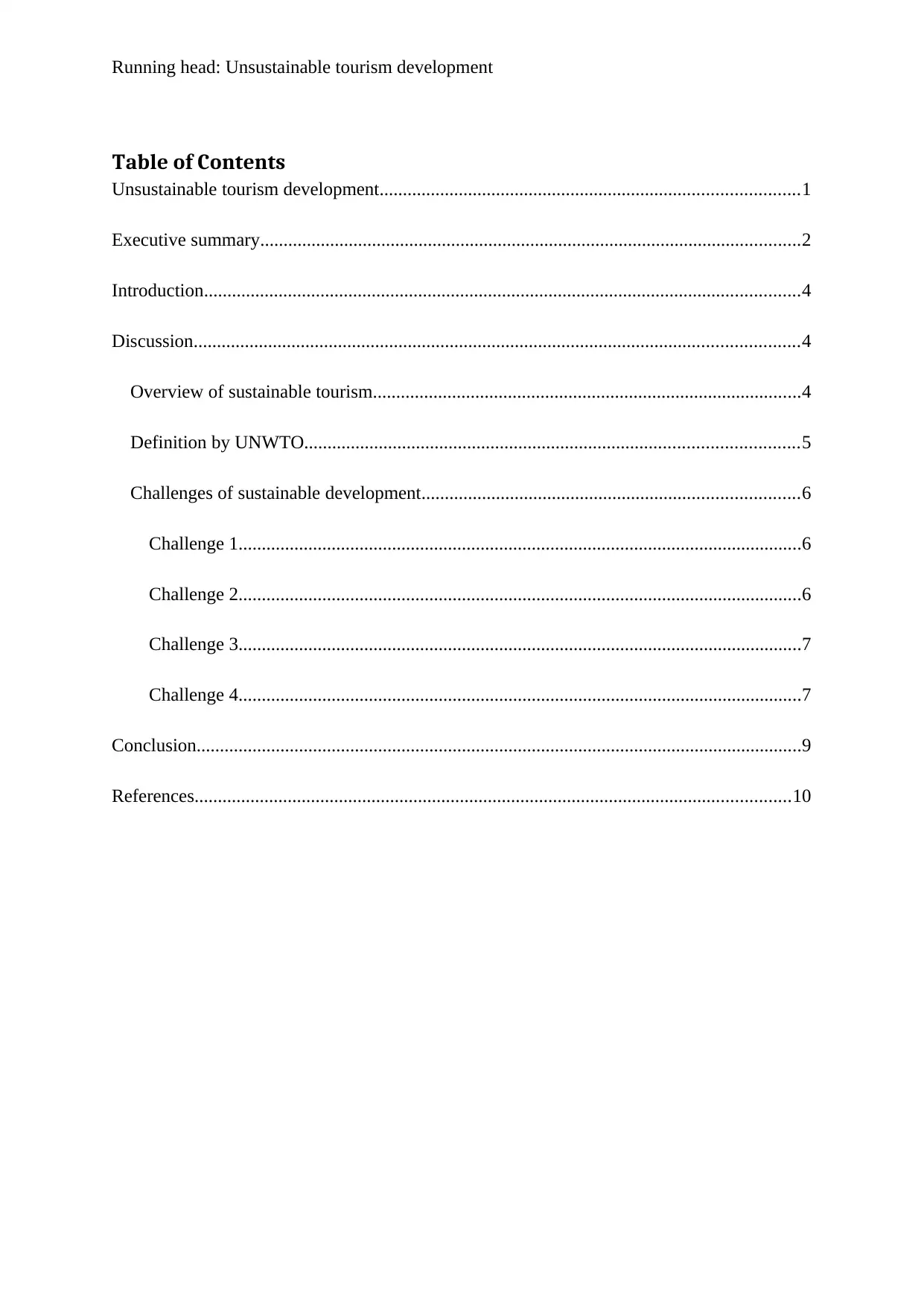
Running head: Unsustainable tourism development
Table of Contents
Unsustainable tourism development..........................................................................................1
Executive summary....................................................................................................................2
Introduction................................................................................................................................4
Discussion..................................................................................................................................4
Overview of sustainable tourism............................................................................................4
Definition by UNWTO..........................................................................................................5
Challenges of sustainable development.................................................................................6
Challenge 1.........................................................................................................................6
Challenge 2.........................................................................................................................6
Challenge 3.........................................................................................................................7
Challenge 4.........................................................................................................................7
Conclusion..................................................................................................................................9
References................................................................................................................................10
Table of Contents
Unsustainable tourism development..........................................................................................1
Executive summary....................................................................................................................2
Introduction................................................................................................................................4
Discussion..................................................................................................................................4
Overview of sustainable tourism............................................................................................4
Definition by UNWTO..........................................................................................................5
Challenges of sustainable development.................................................................................6
Challenge 1.........................................................................................................................6
Challenge 2.........................................................................................................................6
Challenge 3.........................................................................................................................7
Challenge 4.........................................................................................................................7
Conclusion..................................................................................................................................9
References................................................................................................................................10
⊘ This is a preview!⊘
Do you want full access?
Subscribe today to unlock all pages.

Trusted by 1+ million students worldwide
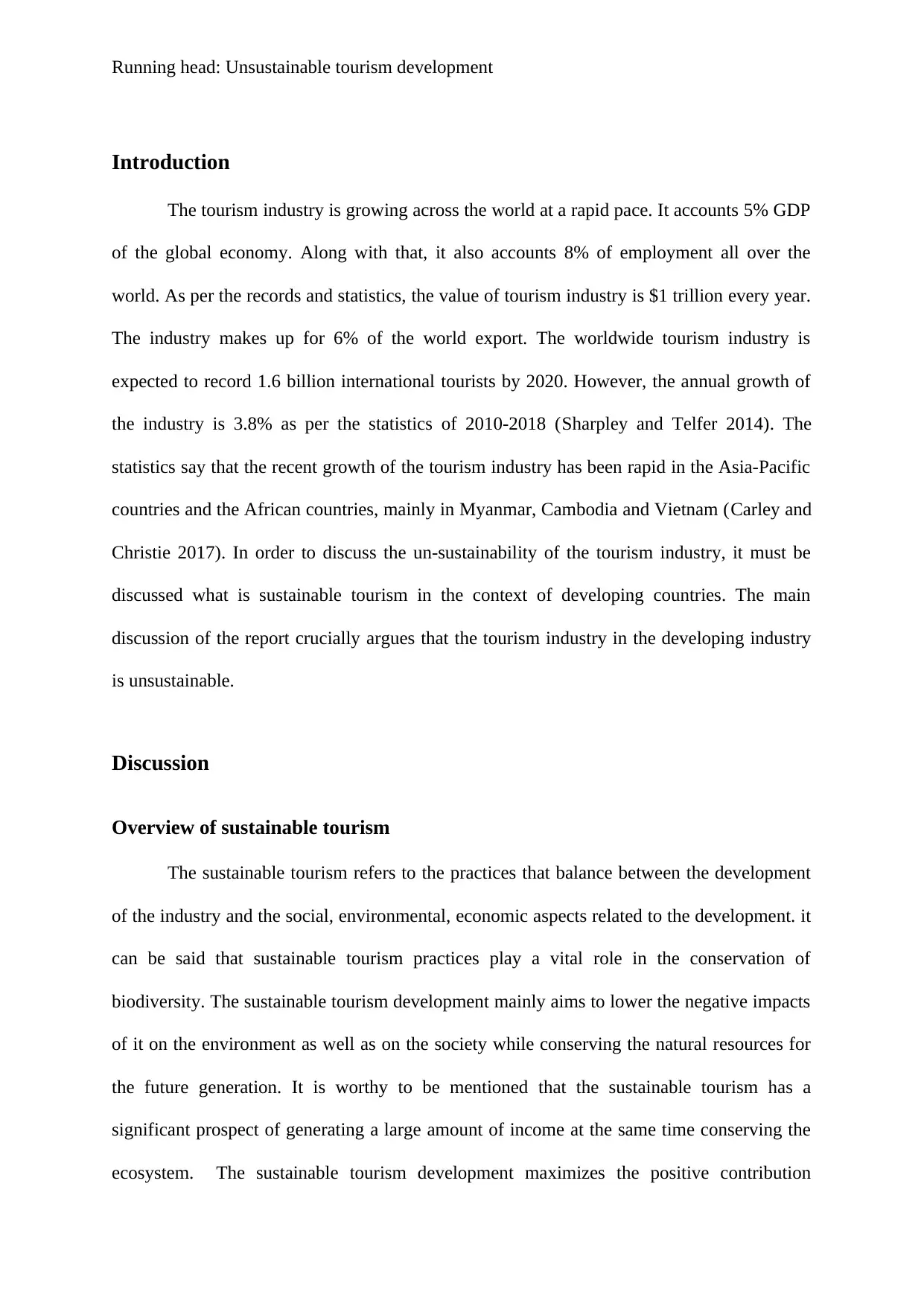
Running head: Unsustainable tourism development
Introduction
The tourism industry is growing across the world at a rapid pace. It accounts 5% GDP
of the global economy. Along with that, it also accounts 8% of employment all over the
world. As per the records and statistics, the value of tourism industry is $1 trillion every year.
The industry makes up for 6% of the world export. The worldwide tourism industry is
expected to record 1.6 billion international tourists by 2020. However, the annual growth of
the industry is 3.8% as per the statistics of 2010-2018 (Sharpley and Telfer 2014). The
statistics say that the recent growth of the tourism industry has been rapid in the Asia-Pacific
countries and the African countries, mainly in Myanmar, Cambodia and Vietnam (Carley and
Christie 2017). In order to discuss the un-sustainability of the tourism industry, it must be
discussed what is sustainable tourism in the context of developing countries. The main
discussion of the report crucially argues that the tourism industry in the developing industry
is unsustainable.
Discussion
Overview of sustainable tourism
The sustainable tourism refers to the practices that balance between the development
of the industry and the social, environmental, economic aspects related to the development. it
can be said that sustainable tourism practices play a vital role in the conservation of
biodiversity. The sustainable tourism development mainly aims to lower the negative impacts
of it on the environment as well as on the society while conserving the natural resources for
the future generation. It is worthy to be mentioned that the sustainable tourism has a
significant prospect of generating a large amount of income at the same time conserving the
ecosystem. The sustainable tourism development maximizes the positive contribution
Introduction
The tourism industry is growing across the world at a rapid pace. It accounts 5% GDP
of the global economy. Along with that, it also accounts 8% of employment all over the
world. As per the records and statistics, the value of tourism industry is $1 trillion every year.
The industry makes up for 6% of the world export. The worldwide tourism industry is
expected to record 1.6 billion international tourists by 2020. However, the annual growth of
the industry is 3.8% as per the statistics of 2010-2018 (Sharpley and Telfer 2014). The
statistics say that the recent growth of the tourism industry has been rapid in the Asia-Pacific
countries and the African countries, mainly in Myanmar, Cambodia and Vietnam (Carley and
Christie 2017). In order to discuss the un-sustainability of the tourism industry, it must be
discussed what is sustainable tourism in the context of developing countries. The main
discussion of the report crucially argues that the tourism industry in the developing industry
is unsustainable.
Discussion
Overview of sustainable tourism
The sustainable tourism refers to the practices that balance between the development
of the industry and the social, environmental, economic aspects related to the development. it
can be said that sustainable tourism practices play a vital role in the conservation of
biodiversity. The sustainable tourism development mainly aims to lower the negative impacts
of it on the environment as well as on the society while conserving the natural resources for
the future generation. It is worthy to be mentioned that the sustainable tourism has a
significant prospect of generating a large amount of income at the same time conserving the
ecosystem. The sustainable tourism development maximizes the positive contribution
Paraphrase This Document
Need a fresh take? Get an instant paraphrase of this document with our AI Paraphraser
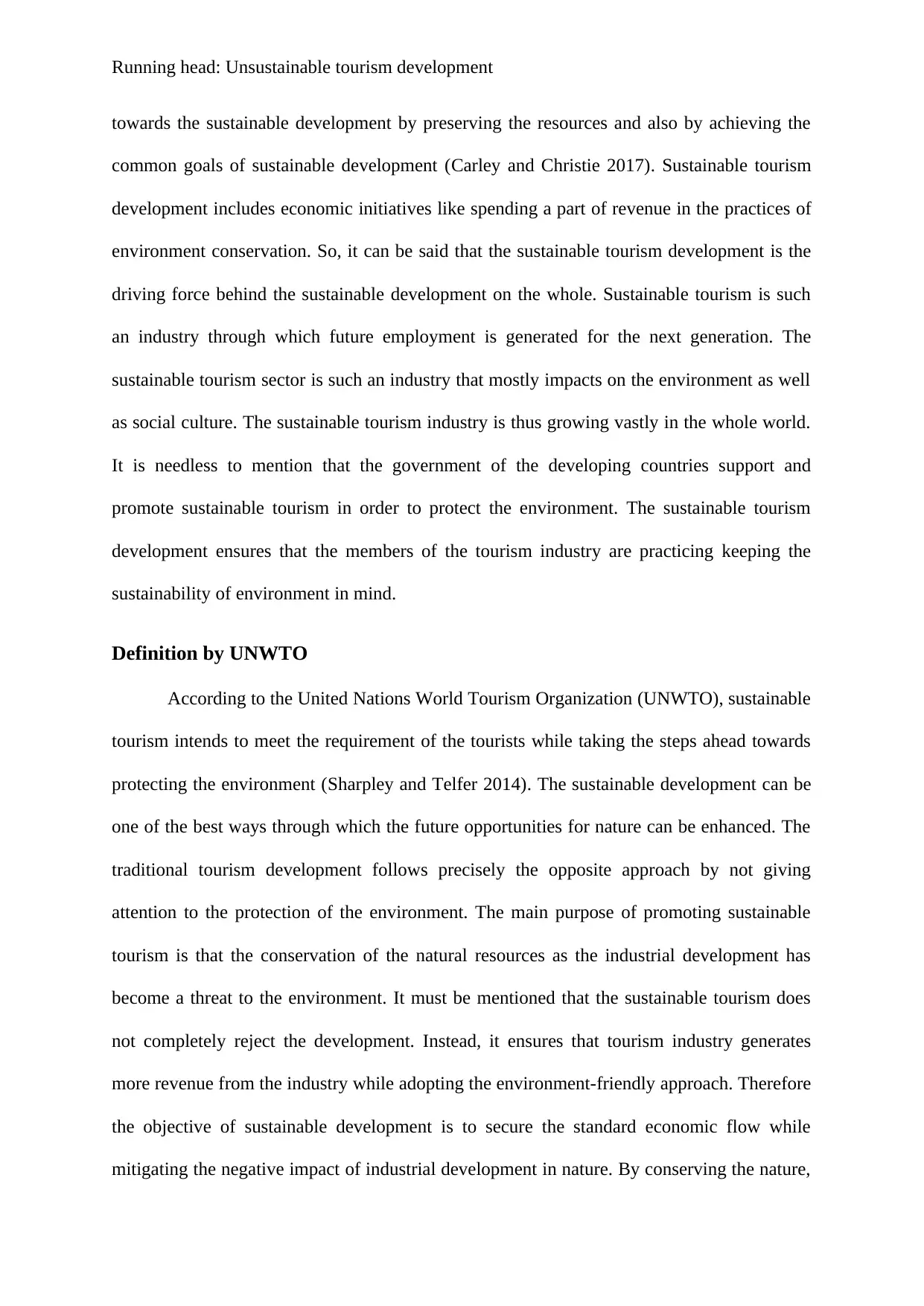
Running head: Unsustainable tourism development
towards the sustainable development by preserving the resources and also by achieving the
common goals of sustainable development (Carley and Christie 2017). Sustainable tourism
development includes economic initiatives like spending a part of revenue in the practices of
environment conservation. So, it can be said that the sustainable tourism development is the
driving force behind the sustainable development on the whole. Sustainable tourism is such
an industry through which future employment is generated for the next generation. The
sustainable tourism sector is such an industry that mostly impacts on the environment as well
as social culture. The sustainable tourism industry is thus growing vastly in the whole world.
It is needless to mention that the government of the developing countries support and
promote sustainable tourism in order to protect the environment. The sustainable tourism
development ensures that the members of the tourism industry are practicing keeping the
sustainability of environment in mind.
Definition by UNWTO
According to the United Nations World Tourism Organization (UNWTO), sustainable
tourism intends to meet the requirement of the tourists while taking the steps ahead towards
protecting the environment (Sharpley and Telfer 2014). The sustainable development can be
one of the best ways through which the future opportunities for nature can be enhanced. The
traditional tourism development follows precisely the opposite approach by not giving
attention to the protection of the environment. The main purpose of promoting sustainable
tourism is that the conservation of the natural resources as the industrial development has
become a threat to the environment. It must be mentioned that the sustainable tourism does
not completely reject the development. Instead, it ensures that tourism industry generates
more revenue from the industry while adopting the environment-friendly approach. Therefore
the objective of sustainable development is to secure the standard economic flow while
mitigating the negative impact of industrial development in nature. By conserving the nature,
towards the sustainable development by preserving the resources and also by achieving the
common goals of sustainable development (Carley and Christie 2017). Sustainable tourism
development includes economic initiatives like spending a part of revenue in the practices of
environment conservation. So, it can be said that the sustainable tourism development is the
driving force behind the sustainable development on the whole. Sustainable tourism is such
an industry through which future employment is generated for the next generation. The
sustainable tourism sector is such an industry that mostly impacts on the environment as well
as social culture. The sustainable tourism industry is thus growing vastly in the whole world.
It is needless to mention that the government of the developing countries support and
promote sustainable tourism in order to protect the environment. The sustainable tourism
development ensures that the members of the tourism industry are practicing keeping the
sustainability of environment in mind.
Definition by UNWTO
According to the United Nations World Tourism Organization (UNWTO), sustainable
tourism intends to meet the requirement of the tourists while taking the steps ahead towards
protecting the environment (Sharpley and Telfer 2014). The sustainable development can be
one of the best ways through which the future opportunities for nature can be enhanced. The
traditional tourism development follows precisely the opposite approach by not giving
attention to the protection of the environment. The main purpose of promoting sustainable
tourism is that the conservation of the natural resources as the industrial development has
become a threat to the environment. It must be mentioned that the sustainable tourism does
not completely reject the development. Instead, it ensures that tourism industry generates
more revenue from the industry while adopting the environment-friendly approach. Therefore
the objective of sustainable development is to secure the standard economic flow while
mitigating the negative impact of industrial development in nature. By conserving the nature,
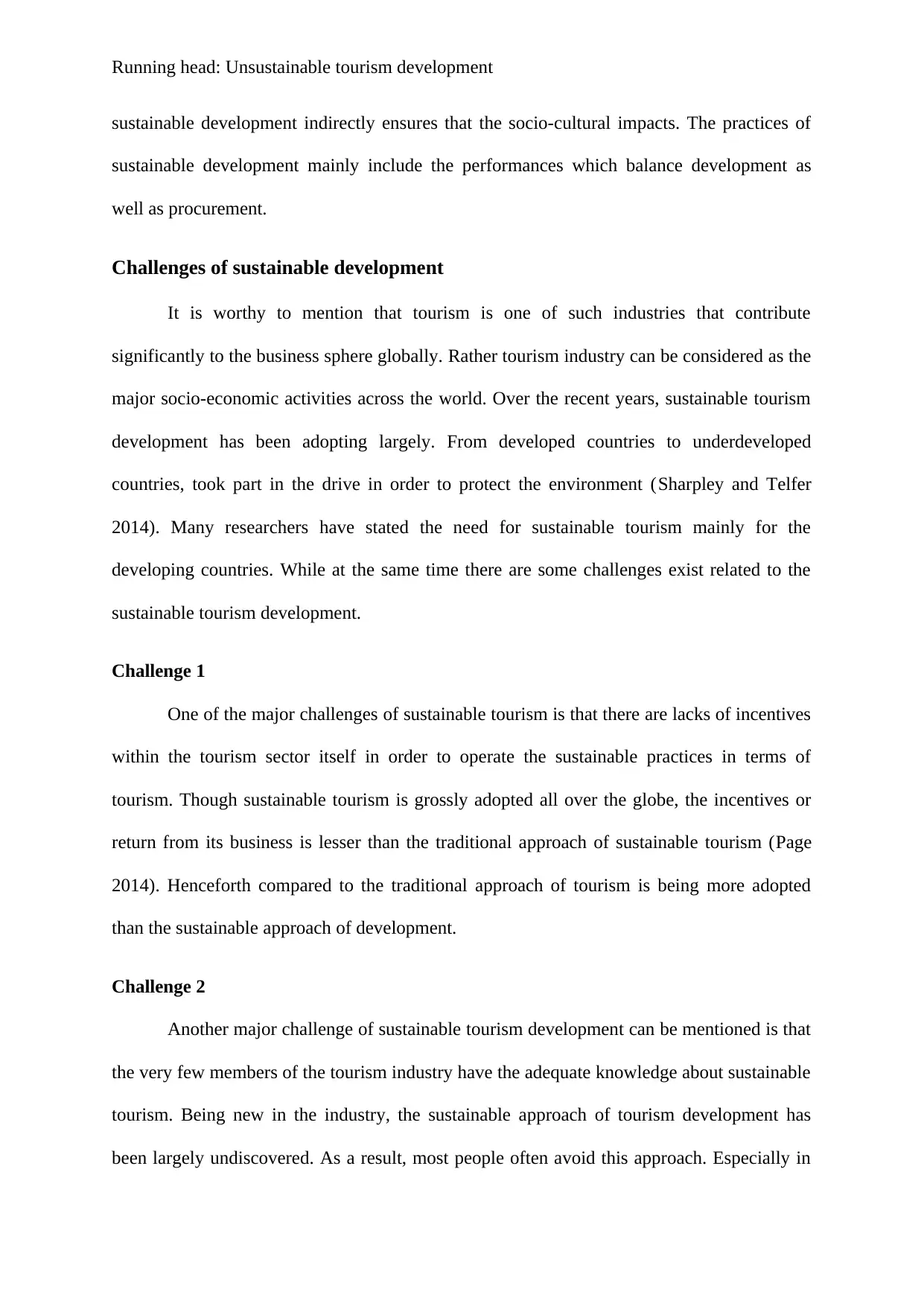
Running head: Unsustainable tourism development
sustainable development indirectly ensures that the socio-cultural impacts. The practices of
sustainable development mainly include the performances which balance development as
well as procurement.
Challenges of sustainable development
It is worthy to mention that tourism is one of such industries that contribute
significantly to the business sphere globally. Rather tourism industry can be considered as the
major socio-economic activities across the world. Over the recent years, sustainable tourism
development has been adopting largely. From developed countries to underdeveloped
countries, took part in the drive in order to protect the environment (Sharpley and Telfer
2014). Many researchers have stated the need for sustainable tourism mainly for the
developing countries. While at the same time there are some challenges exist related to the
sustainable tourism development.
Challenge 1
One of the major challenges of sustainable tourism is that there are lacks of incentives
within the tourism sector itself in order to operate the sustainable practices in terms of
tourism. Though sustainable tourism is grossly adopted all over the globe, the incentives or
return from its business is lesser than the traditional approach of sustainable tourism (Page
2014). Henceforth compared to the traditional approach of tourism is being more adopted
than the sustainable approach of development.
Challenge 2
Another major challenge of sustainable tourism development can be mentioned is that
the very few members of the tourism industry have the adequate knowledge about sustainable
tourism. Being new in the industry, the sustainable approach of tourism development has
been largely undiscovered. As a result, most people often avoid this approach. Especially in
sustainable development indirectly ensures that the socio-cultural impacts. The practices of
sustainable development mainly include the performances which balance development as
well as procurement.
Challenges of sustainable development
It is worthy to mention that tourism is one of such industries that contribute
significantly to the business sphere globally. Rather tourism industry can be considered as the
major socio-economic activities across the world. Over the recent years, sustainable tourism
development has been adopting largely. From developed countries to underdeveloped
countries, took part in the drive in order to protect the environment (Sharpley and Telfer
2014). Many researchers have stated the need for sustainable tourism mainly for the
developing countries. While at the same time there are some challenges exist related to the
sustainable tourism development.
Challenge 1
One of the major challenges of sustainable tourism is that there are lacks of incentives
within the tourism sector itself in order to operate the sustainable practices in terms of
tourism. Though sustainable tourism is grossly adopted all over the globe, the incentives or
return from its business is lesser than the traditional approach of sustainable tourism (Page
2014). Henceforth compared to the traditional approach of tourism is being more adopted
than the sustainable approach of development.
Challenge 2
Another major challenge of sustainable tourism development can be mentioned is that
the very few members of the tourism industry have the adequate knowledge about sustainable
tourism. Being new in the industry, the sustainable approach of tourism development has
been largely undiscovered. As a result, most people often avoid this approach. Especially in
⊘ This is a preview!⊘
Do you want full access?
Subscribe today to unlock all pages.

Trusted by 1+ million students worldwide
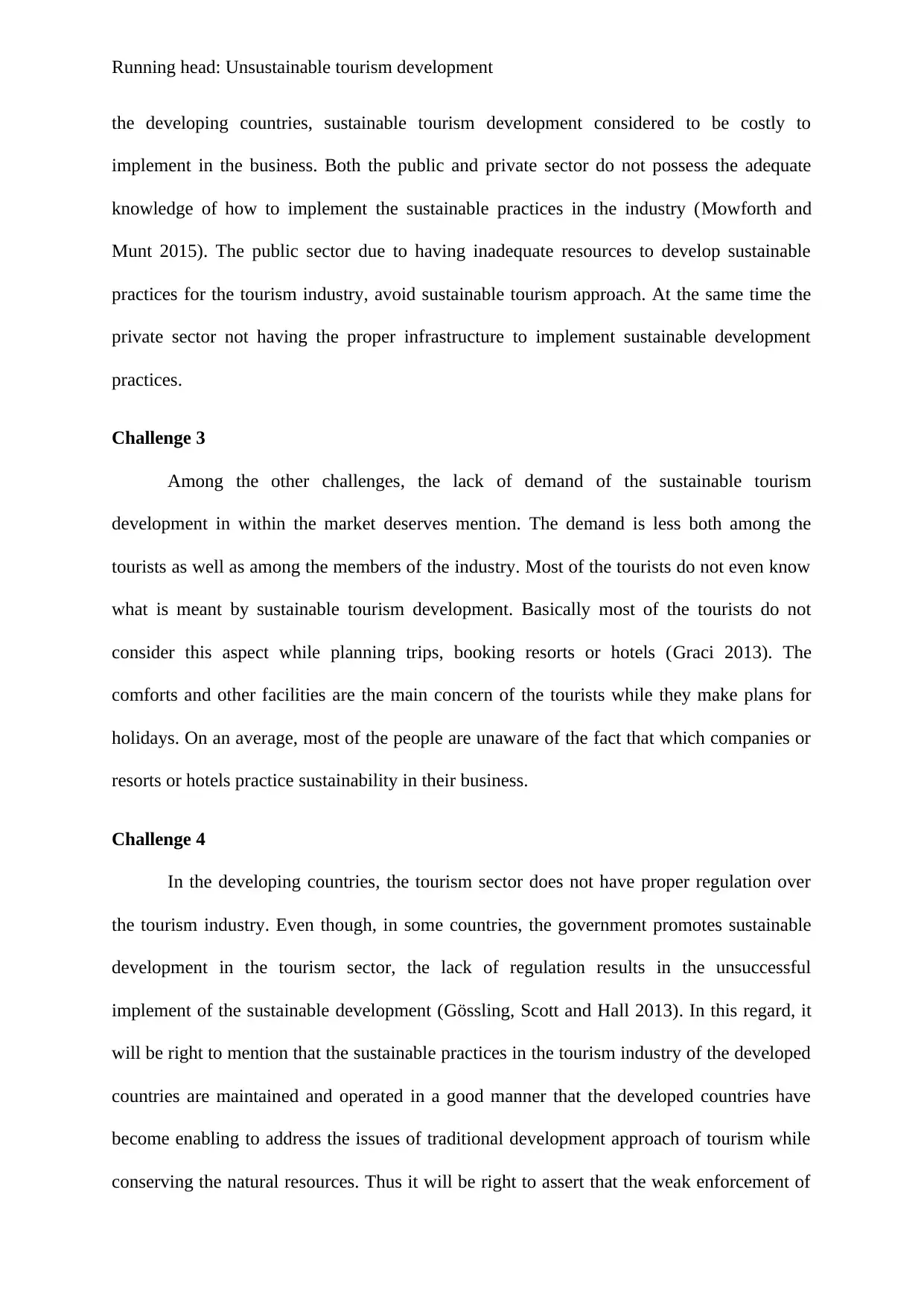
Running head: Unsustainable tourism development
the developing countries, sustainable tourism development considered to be costly to
implement in the business. Both the public and private sector do not possess the adequate
knowledge of how to implement the sustainable practices in the industry (Mowforth and
Munt 2015). The public sector due to having inadequate resources to develop sustainable
practices for the tourism industry, avoid sustainable tourism approach. At the same time the
private sector not having the proper infrastructure to implement sustainable development
practices.
Challenge 3
Among the other challenges, the lack of demand of the sustainable tourism
development in within the market deserves mention. The demand is less both among the
tourists as well as among the members of the industry. Most of the tourists do not even know
what is meant by sustainable tourism development. Basically most of the tourists do not
consider this aspect while planning trips, booking resorts or hotels (Graci 2013). The
comforts and other facilities are the main concern of the tourists while they make plans for
holidays. On an average, most of the people are unaware of the fact that which companies or
resorts or hotels practice sustainability in their business.
Challenge 4
In the developing countries, the tourism sector does not have proper regulation over
the tourism industry. Even though, in some countries, the government promotes sustainable
development in the tourism sector, the lack of regulation results in the unsuccessful
implement of the sustainable development (Gössling, Scott and Hall 2013). In this regard, it
will be right to mention that the sustainable practices in the tourism industry of the developed
countries are maintained and operated in a good manner that the developed countries have
become enabling to address the issues of traditional development approach of tourism while
conserving the natural resources. Thus it will be right to assert that the weak enforcement of
the developing countries, sustainable tourism development considered to be costly to
implement in the business. Both the public and private sector do not possess the adequate
knowledge of how to implement the sustainable practices in the industry (Mowforth and
Munt 2015). The public sector due to having inadequate resources to develop sustainable
practices for the tourism industry, avoid sustainable tourism approach. At the same time the
private sector not having the proper infrastructure to implement sustainable development
practices.
Challenge 3
Among the other challenges, the lack of demand of the sustainable tourism
development in within the market deserves mention. The demand is less both among the
tourists as well as among the members of the industry. Most of the tourists do not even know
what is meant by sustainable tourism development. Basically most of the tourists do not
consider this aspect while planning trips, booking resorts or hotels (Graci 2013). The
comforts and other facilities are the main concern of the tourists while they make plans for
holidays. On an average, most of the people are unaware of the fact that which companies or
resorts or hotels practice sustainability in their business.
Challenge 4
In the developing countries, the tourism sector does not have proper regulation over
the tourism industry. Even though, in some countries, the government promotes sustainable
development in the tourism sector, the lack of regulation results in the unsuccessful
implement of the sustainable development (Gössling, Scott and Hall 2013). In this regard, it
will be right to mention that the sustainable practices in the tourism industry of the developed
countries are maintained and operated in a good manner that the developed countries have
become enabling to address the issues of traditional development approach of tourism while
conserving the natural resources. Thus it will be right to assert that the weak enforcement of
Paraphrase This Document
Need a fresh take? Get an instant paraphrase of this document with our AI Paraphraser
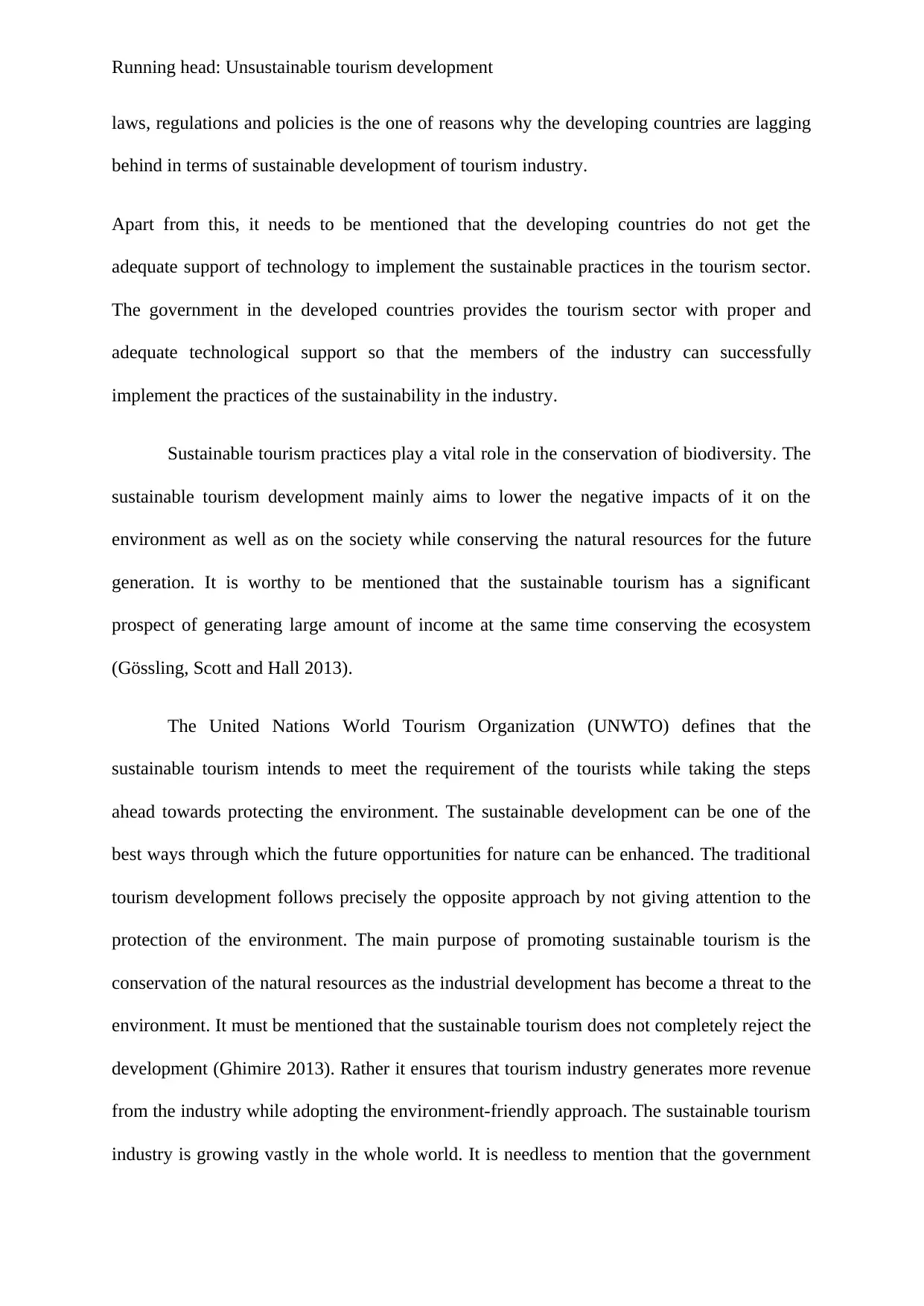
Running head: Unsustainable tourism development
laws, regulations and policies is the one of reasons why the developing countries are lagging
behind in terms of sustainable development of tourism industry.
Apart from this, it needs to be mentioned that the developing countries do not get the
adequate support of technology to implement the sustainable practices in the tourism sector.
The government in the developed countries provides the tourism sector with proper and
adequate technological support so that the members of the industry can successfully
implement the practices of the sustainability in the industry.
Sustainable tourism practices play a vital role in the conservation of biodiversity. The
sustainable tourism development mainly aims to lower the negative impacts of it on the
environment as well as on the society while conserving the natural resources for the future
generation. It is worthy to be mentioned that the sustainable tourism has a significant
prospect of generating large amount of income at the same time conserving the ecosystem
(Gössling, Scott and Hall 2013).
The United Nations World Tourism Organization (UNWTO) defines that the
sustainable tourism intends to meet the requirement of the tourists while taking the steps
ahead towards protecting the environment. The sustainable development can be one of the
best ways through which the future opportunities for nature can be enhanced. The traditional
tourism development follows precisely the opposite approach by not giving attention to the
protection of the environment. The main purpose of promoting sustainable tourism is the
conservation of the natural resources as the industrial development has become a threat to the
environment. It must be mentioned that the sustainable tourism does not completely reject the
development (Ghimire 2013). Rather it ensures that tourism industry generates more revenue
from the industry while adopting the environment-friendly approach. The sustainable tourism
industry is growing vastly in the whole world. It is needless to mention that the government
laws, regulations and policies is the one of reasons why the developing countries are lagging
behind in terms of sustainable development of tourism industry.
Apart from this, it needs to be mentioned that the developing countries do not get the
adequate support of technology to implement the sustainable practices in the tourism sector.
The government in the developed countries provides the tourism sector with proper and
adequate technological support so that the members of the industry can successfully
implement the practices of the sustainability in the industry.
Sustainable tourism practices play a vital role in the conservation of biodiversity. The
sustainable tourism development mainly aims to lower the negative impacts of it on the
environment as well as on the society while conserving the natural resources for the future
generation. It is worthy to be mentioned that the sustainable tourism has a significant
prospect of generating large amount of income at the same time conserving the ecosystem
(Gössling, Scott and Hall 2013).
The United Nations World Tourism Organization (UNWTO) defines that the
sustainable tourism intends to meet the requirement of the tourists while taking the steps
ahead towards protecting the environment. The sustainable development can be one of the
best ways through which the future opportunities for nature can be enhanced. The traditional
tourism development follows precisely the opposite approach by not giving attention to the
protection of the environment. The main purpose of promoting sustainable tourism is the
conservation of the natural resources as the industrial development has become a threat to the
environment. It must be mentioned that the sustainable tourism does not completely reject the
development (Ghimire 2013). Rather it ensures that tourism industry generates more revenue
from the industry while adopting the environment-friendly approach. The sustainable tourism
industry is growing vastly in the whole world. It is needless to mention that the government
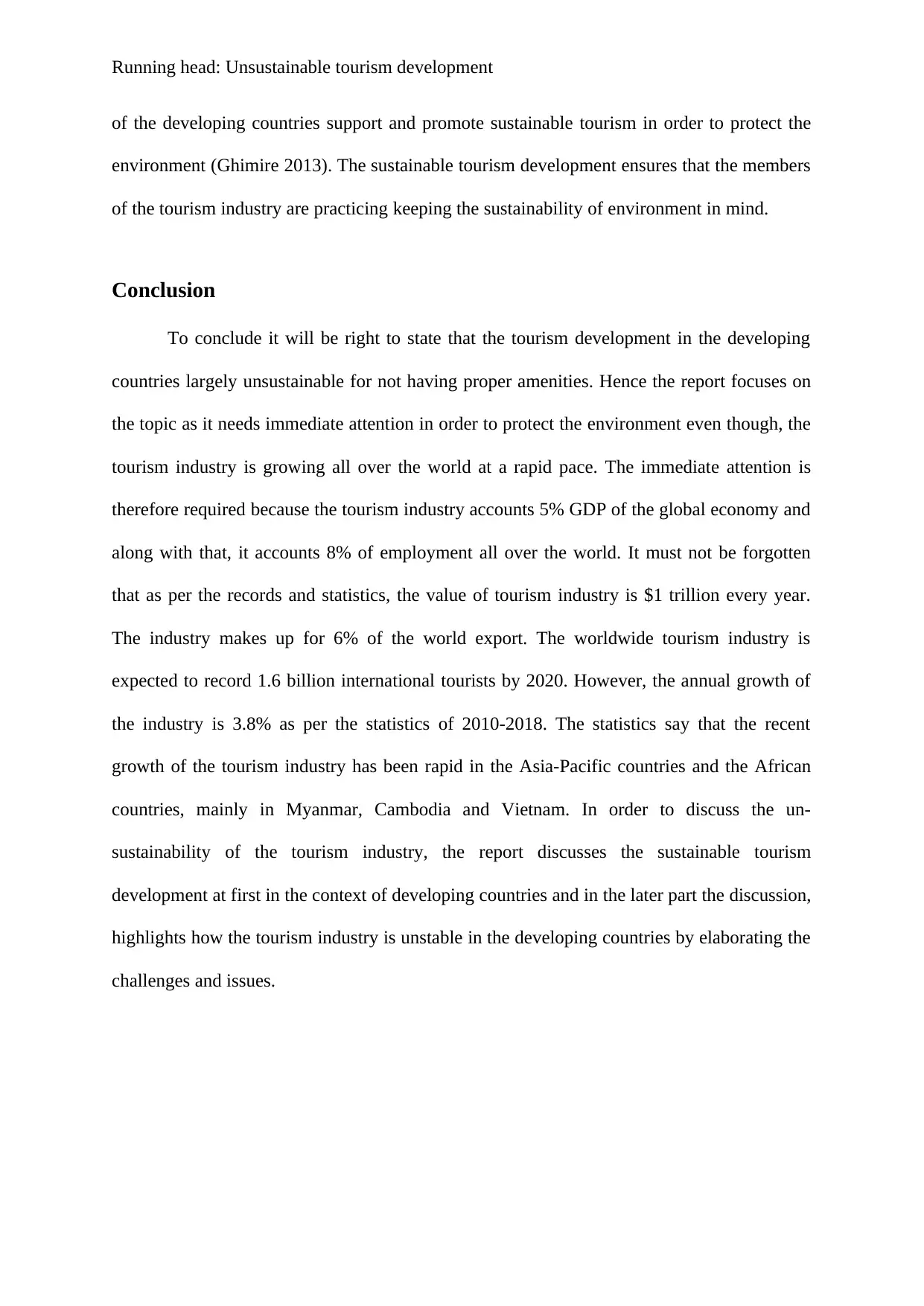
Running head: Unsustainable tourism development
of the developing countries support and promote sustainable tourism in order to protect the
environment (Ghimire 2013). The sustainable tourism development ensures that the members
of the tourism industry are practicing keeping the sustainability of environment in mind.
Conclusion
To conclude it will be right to state that the tourism development in the developing
countries largely unsustainable for not having proper amenities. Hence the report focuses on
the topic as it needs immediate attention in order to protect the environment even though, the
tourism industry is growing all over the world at a rapid pace. The immediate attention is
therefore required because the tourism industry accounts 5% GDP of the global economy and
along with that, it accounts 8% of employment all over the world. It must not be forgotten
that as per the records and statistics, the value of tourism industry is $1 trillion every year.
The industry makes up for 6% of the world export. The worldwide tourism industry is
expected to record 1.6 billion international tourists by 2020. However, the annual growth of
the industry is 3.8% as per the statistics of 2010-2018. The statistics say that the recent
growth of the tourism industry has been rapid in the Asia-Pacific countries and the African
countries, mainly in Myanmar, Cambodia and Vietnam. In order to discuss the un-
sustainability of the tourism industry, the report discusses the sustainable tourism
development at first in the context of developing countries and in the later part the discussion,
highlights how the tourism industry is unstable in the developing countries by elaborating the
challenges and issues.
of the developing countries support and promote sustainable tourism in order to protect the
environment (Ghimire 2013). The sustainable tourism development ensures that the members
of the tourism industry are practicing keeping the sustainability of environment in mind.
Conclusion
To conclude it will be right to state that the tourism development in the developing
countries largely unsustainable for not having proper amenities. Hence the report focuses on
the topic as it needs immediate attention in order to protect the environment even though, the
tourism industry is growing all over the world at a rapid pace. The immediate attention is
therefore required because the tourism industry accounts 5% GDP of the global economy and
along with that, it accounts 8% of employment all over the world. It must not be forgotten
that as per the records and statistics, the value of tourism industry is $1 trillion every year.
The industry makes up for 6% of the world export. The worldwide tourism industry is
expected to record 1.6 billion international tourists by 2020. However, the annual growth of
the industry is 3.8% as per the statistics of 2010-2018. The statistics say that the recent
growth of the tourism industry has been rapid in the Asia-Pacific countries and the African
countries, mainly in Myanmar, Cambodia and Vietnam. In order to discuss the un-
sustainability of the tourism industry, the report discusses the sustainable tourism
development at first in the context of developing countries and in the later part the discussion,
highlights how the tourism industry is unstable in the developing countries by elaborating the
challenges and issues.
⊘ This is a preview!⊘
Do you want full access?
Subscribe today to unlock all pages.

Trusted by 1+ million students worldwide
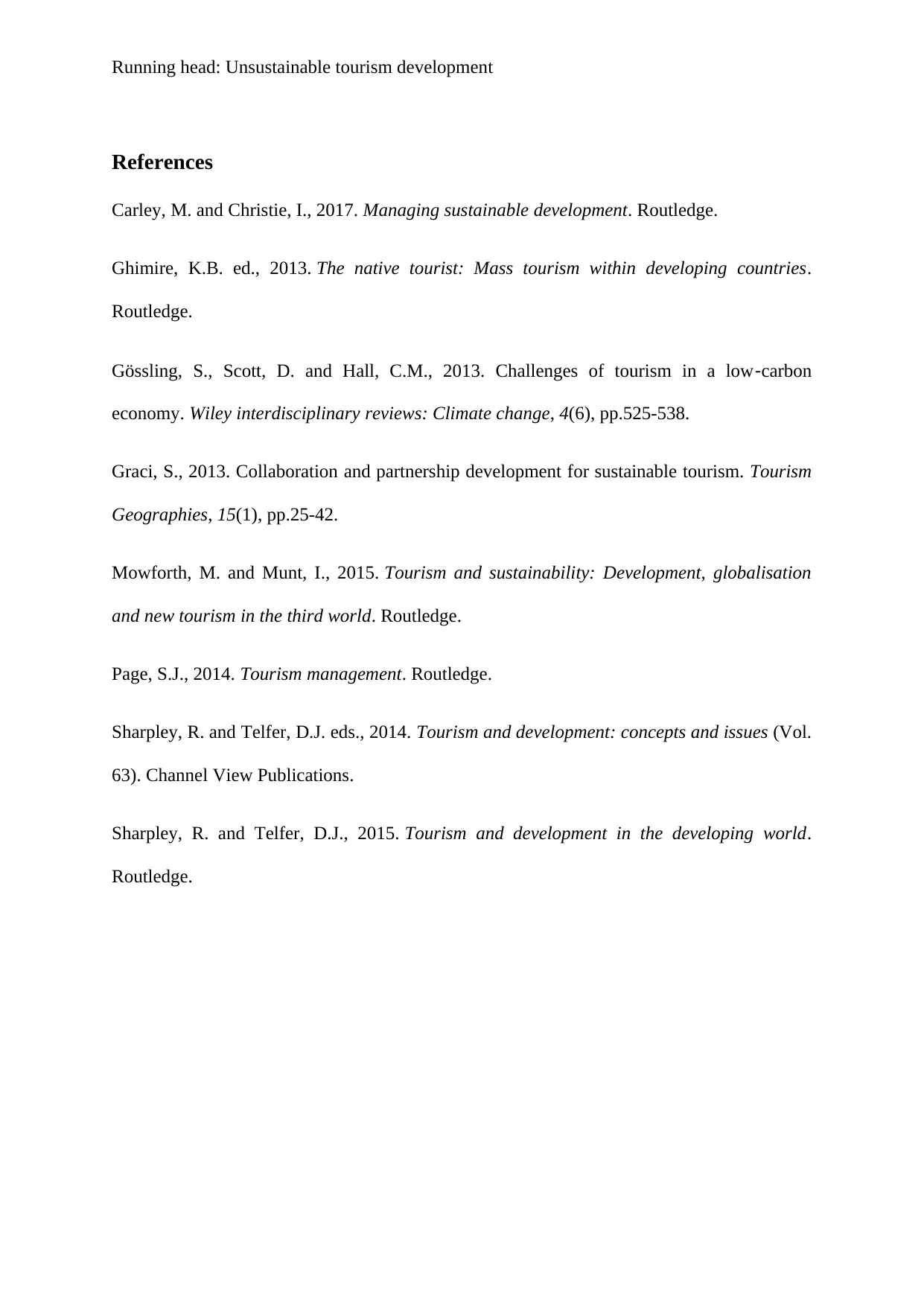
Running head: Unsustainable tourism development
References
Carley, M. and Christie, I., 2017. Managing sustainable development. Routledge.
Ghimire, K.B. ed., 2013. The native tourist: Mass tourism within developing countries.
Routledge.
Gössling, S., Scott, D. and Hall, C.M., 2013. Challenges of tourism in a low‐carbon
economy. Wiley interdisciplinary reviews: Climate change, 4(6), pp.525-538.
Graci, S., 2013. Collaboration and partnership development for sustainable tourism. Tourism
Geographies, 15(1), pp.25-42.
Mowforth, M. and Munt, I., 2015. Tourism and sustainability: Development, globalisation
and new tourism in the third world. Routledge.
Page, S.J., 2014. Tourism management. Routledge.
Sharpley, R. and Telfer, D.J. eds., 2014. Tourism and development: concepts and issues (Vol.
63). Channel View Publications.
Sharpley, R. and Telfer, D.J., 2015. Tourism and development in the developing world.
Routledge.
References
Carley, M. and Christie, I., 2017. Managing sustainable development. Routledge.
Ghimire, K.B. ed., 2013. The native tourist: Mass tourism within developing countries.
Routledge.
Gössling, S., Scott, D. and Hall, C.M., 2013. Challenges of tourism in a low‐carbon
economy. Wiley interdisciplinary reviews: Climate change, 4(6), pp.525-538.
Graci, S., 2013. Collaboration and partnership development for sustainable tourism. Tourism
Geographies, 15(1), pp.25-42.
Mowforth, M. and Munt, I., 2015. Tourism and sustainability: Development, globalisation
and new tourism in the third world. Routledge.
Page, S.J., 2014. Tourism management. Routledge.
Sharpley, R. and Telfer, D.J. eds., 2014. Tourism and development: concepts and issues (Vol.
63). Channel View Publications.
Sharpley, R. and Telfer, D.J., 2015. Tourism and development in the developing world.
Routledge.
1 out of 10
Related Documents
Your All-in-One AI-Powered Toolkit for Academic Success.
+13062052269
info@desklib.com
Available 24*7 on WhatsApp / Email
![[object Object]](/_next/static/media/star-bottom.7253800d.svg)
Unlock your academic potential
Copyright © 2020–2025 A2Z Services. All Rights Reserved. Developed and managed by ZUCOL.





